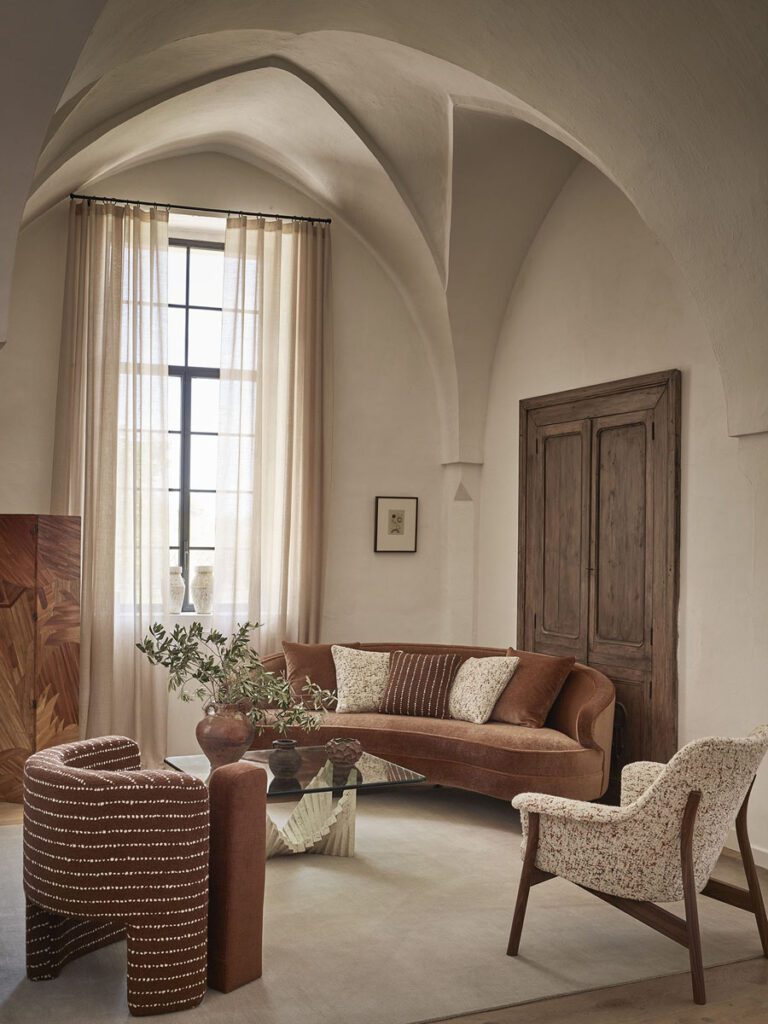“Designing, for me, is an emotional process,” says Rosemary Hallgarten. “It’s all about feeling.”
That’s a very astute comment considering that the British-born designer’s rugs and textiles are so tactile and textural that you can’t help but reach out and touch them, even if you view them only in photographs in the pages of a magazine.
Hallgarten, who established her eponymous company a little over two decades ago, creates two collections each year. Her to-the-trade designs are sold in showrooms around the country.
Her newest launch, which she christened Aurora after the Roman goddess of the dawn, in comfort-cocoon hues of chocolate, cognac, blue-gray, and olive-green, draws its inspiration from summer’s waning light, the Baroque era, and the cathedral-like domed ceilings that held her eye during a recent trip to Puglia in Italy’s high-heeled boot.


“I always like to combine the ancient with the new,” she says, adding that Aurora “bumps up the sense of texture, warmth, and coziness.”
When you see Aurora, which Hallgarten says “speaks to a sense of Italy and its rich decorative history,” you can’t help but feel transported to the ancient towns of Puglia, where sunlight plays hide-and-seek in the arch of every wall and the curve of every doorway.
Hallgarten’s Ombre Glacier rug, whose organic pattern appears to cascade over its wool base, features what she calls a “shimmer” of gold highlighting the high-pile silk that mimics the light. The contrast of flat wool and high-pile silk in the Glacier series becomes a warm embrace that invites you to wrap yourself in luxury. “That’s the feeling I want to create—they are soft and comfortable enough to wear,” she says.Her Ombre Arch rugs, designed to complement curved furniture, are defined by a subtle, oh-so-soft-to-the-touch arch pattern.
Some of Hallgarten’s designs, such as Shiitake, skillfully create textural landscapes through the gradation of a single solid color.






When she’s designing, Hallgarten always starts with contrasting textures and materials—undyed alpaca fibers, sheep shearling, and brushed baby alpaca fibers—and builds her big ideas upon “little thoughts.” She makes sketches, and then produces samples until “everything comes together,” a process she likens to blending all the ingredients together much as a pastry chef does when baking a complex cake.
Long before sustainability was de rigueur in the fashion and design worlds, Hallgarten embraced it, commissioning craftspeople from Peru, Nepal, Brazil, and Turkey to bring her creations to life.
“When I started my company in 2001, I wasn’t thinking about sustainability per se,” she says. “I wanted to do something that no one else was doing. I fell in love with Peru and its history and its rich traditions. I saw it as a challenge to take the skills of these craftspeople, who were making traditional-style products for tourists, and translate their skills and designs to create a wider audience to keep them working.”
Feeling the hand of the artisan at work is what makes Hallgarten’s designs so special. It is, she says, “the difference between an oil or acrylic painting and a print—the print doesn’t have soul.”




In addition to supporting indigenous cultures, Hallgarten uses sustainable materials, including Peruvian alpaca fibers (the fleece has many colors), Tibetan wool (Himalayan sheep grow one of the more luxurious wools in the world), Tibetan cactus, nettles, and hemp (featured in her Botanical Collection), and Brazilian cotton, wool, rustic silk, banana, leather, jute, and sisal (no Amazon rainforests were harmed).
Hallgarten is a second-generation craftsperson. Her mother, Gloria Finn, turned the paintings of Milton Avery, Theodoros Stamos, Hans Mueller, and Anni Albers into floor coverings.
Early in her career, Hallgarten focused on jewelry; her first rugs, Falling Leaf, were inspired by her original creations. “Jewelry and rugs and textiles all have texture,” she says. “I’ve always loved chain mail, and it led me to jewelry. But I wanted to design something softer and to play with color.”Hallgarten, who is based in Connecticut, keeps in close contact with the artisans in her fold, visiting them often; she’s worked with many of them for decades.
“Everything I do comes from passion,” she says, adding that she creates designs that “are what I want in my own home. I feel lucky that I can keep on doing it.”


